GEORGETOWN, SOUTH CAROLINA – ” The city of Georgetown is situated on the north side of the Sampit f River and near its junction with the Black River, where both empty into Winyah Bay, ten miles from the Atlantic Ocean. It is reached either by the water from Charleston or by rail on the Atlantic Coast Line to Lane’s Station, and thence by the Georgetown and Northwestern Railroad. The approach to the city from the west is by the railroad, and the first glimpse as the train reaches the station is neither exhilarating nor prepossessing.

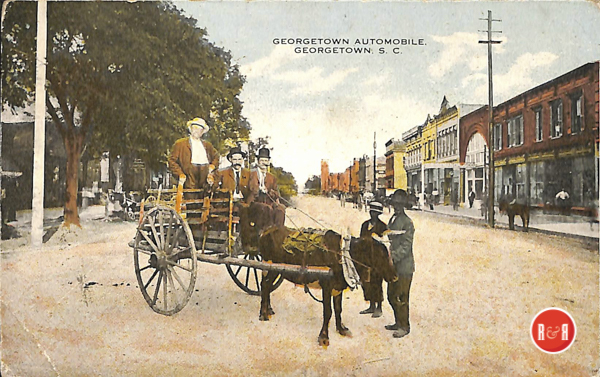
Early postcards of the area, courtesy of the AFLLC Collection – 2017
The outskirts are composed of scattered houses, which have all the 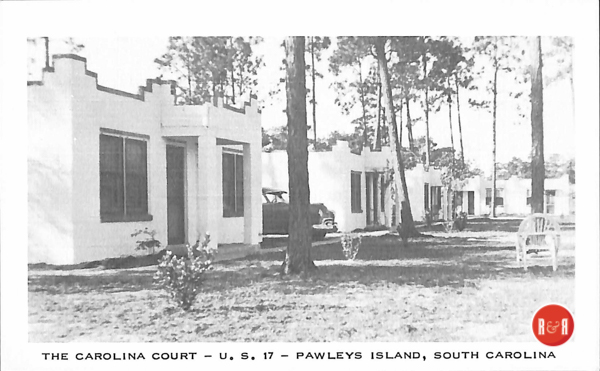
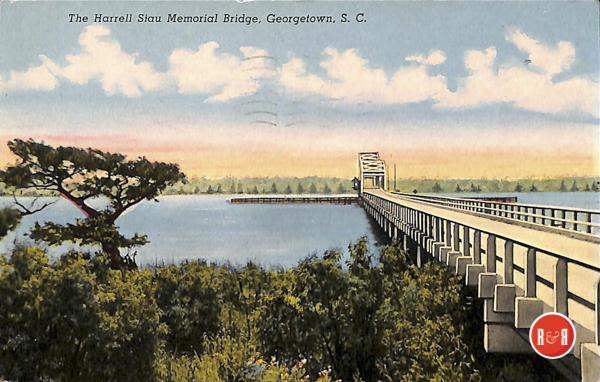 appearances of having been built before the Revolutionary War. They are mostly small, one-story buildings that have been innocent of paint or whitewash certainly beyond the recollection of the last two generations. The illusion is at once conveyed from this point of observation of a dead, certainly a sleeping, city, but the fancy is at once dispelled by the hum of the machinery and the clouds of smoke from the magnificent building of the Georgetown Rice Milling Company.
appearances of having been built before the Revolutionary War. They are mostly small, one-story buildings that have been innocent of paint or whitewash certainly beyond the recollection of the last two generations. The illusion is at once conveyed from this point of observation of a dead, certainly a sleeping, city, but the fancy is at once dispelled by the hum of the machinery and the clouds of smoke from the magnificent building of the Georgetown Rice Milling Company.
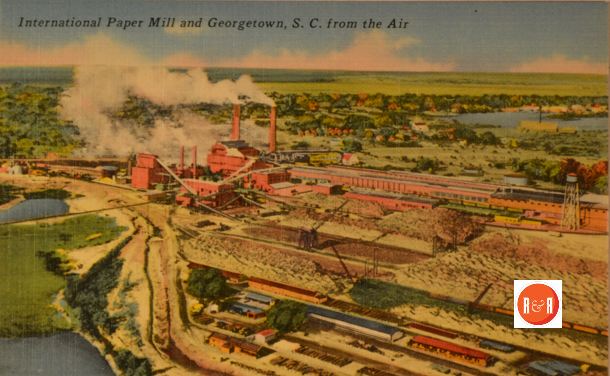
International Paper Mill brought badly needed jobs to Georgetown County, S.C. Courtesy of the Martin Postcard Collection – 2014
The outbuildings, too, the smaller ones, are in all stages of decay, with rapidly disappearing roofs, weather-beaten and sun-cracked walls, and a degree of architectural abandon that is in vivid contrast with other towns and cities in South Carolina, and especially at this stage of industrial and commercial life.
There is nothing peculiar about the architecture of Georgetown with the exception, perhaps, of piazzas that were intended originally to cover as much of the pavement as possible. This is an old, very old style, which has not lately been followed in the new houses that have been erected since the war. The business street, called Front Street, runs along the Sampit water front. With this a half a dozen or more streets run parallel, and the others are perpendicular to this base line. But these streets are of exceeding beauty. They are wide and on either side are low rows of white oaks as a rule. One of these, High Market Street, is perhaps the most picturesque in South Carolina. Once upon a time these rivers poured their golden agricultural harvest into the lap of Georgetown. Rice was the royal crop, and it succeeded the indigo crops, which have passed out of history save in the records of the time-honored Winyah Indigo Society, a distinctive literary and social bed-rock institution of South Carolina. The wealth and magnificence of those times are now, however, only recollections. Except in a few instances the rice field of today is a small affair compared with the rice estates of the early and middle years of this century. The contrast of what was and what is may best be understood from the fact given by an old planter that before the war the rice crop of the country amounted to 120,000 barrels and that this day it averages about 35,000 barrels.
Yet there has been an awakening. Other industries were found to be profitable, among them, shingles, crossties, fish, oysters, game, cotton, lumber, rosin, and turpentine. The first streak of the dawn was the Georgetown and Lane’s Railroad, the work of constructing which was begun in November, 1882. At the Georgetown terminus of the road, which is only thirty-six miles in length, there has been built an ample wharf, alongside of which the largest steamers can anchor. Besides this, a side track has been built to the Georgetown Rice Mills, through which passes a very large portion of the rice product of the county. It is claimed by the management of the road that they have already divided the transportation of rice to Charleston with the steamship line and credit themselves with having shipped 4,000 barrels to

Hauling cotton to market was a pivotal need for small farmers in the region. Using oxen to do the hauling was a time tested – dependable method. Courtesy of the Miriam and Ira D. Wallach Division of Art, Prints and Photographs: Print Collection, The New York Public Library. The New York Public Library Digital Collections
Charleston last year. Besides this, they offer through rates to New York and come into active competition with the packet lines for nearly all classes of freight. The fish trade to New York, Philadelphia, and generally North is virtually controlled by this road, and the value of their trade, including oysters and game, is valued at about $75,000 for the present year. The lumber trade and the crosstie business of the road is also very large. The road is fairly well equipped for business, being well supplied with freight cars, and the passenger accommodations are now admirable.
It gives to the people of Georgetown a double daily mail, a luxury that was impossible before the road was built, the trip from Georgetown to Lane’s being accomplished in one hour and twenty minutes. Formerly the few commercial men who visited Georgetown drove across the country from Kingstree, a distance of about forty miles. Nowadays the hotel here is crowded with these harbingers of prosperity from one end of the week to the other. It is said that the ultimate aim of the road is to reach out into central and northern South Carolina and divert to Georgetown whatever trade goes at this time to Wilmington and thence further north. However true or feasible this may be, it is certain that the owners of the road are making an effort to continue the line by sea from Georgetown to New York by means of the steamship line which has just been established. The object of this new movement is two-fold. First, to compete with the two packet lines in which J. Kamanski & Co. and Congdon, Hazard & Co. of this place are largely interested; and, secondly, in the perhaps remote future to transport freights that now go to Wilmington. There will doubtless be a war of rates between the packet lines and the new steamer, which, it is said, will only end with the withdrawal of either.
The Yorkville Enquirer reported on Nov. 29, 1883 – “The Georgetown and Lanes RR has been completed and is now ready for business.” Later the paper reported on Oct. 13, 1886 – “The Georgetown and Lane’s RR was sold at auction in Charleston on Oct. 5th. The line runs from Georgetown to Lane’s Station, a distance of 36 miles. It was completed in 1883 at a cost of $425,000. The railroad owed $325,000. in a first mortgage. Foreclosure occurred in 1885 and at the recent auction it was purchased by Major W.H. Brawley for $80,000., the agent for the bond holders.”
Standing on any one of the wharves along the river front the signs of progress are everywhere visible. On the south is to be seen the building of the Palmetto Lumber Company, and north the imposing structure of the Georgetown Rice Mills, and just beyond the latter the wharf of the Georgetown and Northwestern Railroad. At the railway wharf there are coastwise vessels at anchor, and at every wharf along the river there are light-draft river steamers and schooners loading and unloading. Everybody is busy; everybody, in fact, is taking part in the revival, and to an outsider the appearances are that everybody is terribly in earnest. Four years ago Georgetown beat its own $3,000,000 business record of ante-bellum days when the bay and the Sampit River floated in the business center of the town.
This amount of business will appear to be almost phenomenal when it is taken into account that the population of Georgetown is only about 3,000, of which, it is said, only the third part is white. All the business is done on Front Street, which suffered during and after the war by fire. The merchants number, perhaps, about sixty and, as may be inferred from the amount of business, carry fine stocks. Among the most important and extensive dealers are H. Kaminski & Co., wholesale and retail groceries, rice, and naval stores, a handsome, three-story brick store and stocked from the cellar to the roof; Congdon & Hazard, same line of business; Butler & Lowenthal, general merchandise; John Voss, groceries, fish, game, and crossties; I. Sittenfield, general merchandise; G.A. Lohr, general merchandise; S. Brilles, fancy goods; F. Young, merchandise and bakery; L.G. Emanuel, general merchandise; Marks, Moses & Bro., general merchandise; Butler & Scheck, general merchandise; C.H. Ortman, groceries; Dr. T.B. Bailey, drug store; and J. A. Iseman, the Norman Drug Store. Only recently the merchants have formed themselves into a board of trade, and it is expected that within the year every merchant in the city will have become a member. A by no means unimportant part of the business of Georgetown is the shad fisheries. The fishing begins about the middle of January and continues from two and a half to three months. The fishermen are permitted by law to fish from Tuesday morning until sunset on

Postcard image courtesy of the Revels Collection – 2015
Thursday of each week, the rest of the week being reserved to give the fish free access to the upper waters of the bay.
The method of capturing the fish is very simple. A net sometimes three hundred yards in length and from twelve to fourteen feet in depth is floated by means of bobbins. The off end of the net is floated by a buoy, and the near end is attached to a small boat in which there are two fishermen. The net by means of leads rests in the water perpendicularly, the whole trap being permitted to drift up and down with the tides.
As the bay is about two miles wide, or about 3,520 yards, it would require about a dozen of the largest nets to span the sheet of water and shut out the shad from upward progress at least through a depth of fourteen feet. Two trips were made over the bay by this correspondent and in no case was anything approaching such an arrangement noted. The nets appeared to be disposed haphazard. The line of the net in the majority of cases almost doubled in upon itself and reduced its length practically about one-third, not withstanding the effort to keep it perpendicular to the shore. The off ends of the net are kept well off shore to avoid snags and other obstructions.
There are about one hundred and fifty men engaged as fishermen, many of whom are white. The value of the trade is now estimated at from $60,000 to $75,000. The fishermen get about twenty-five cents apiece for the fish. The trade is practically controlled in bulk by John Voss and the resident agents of Philadelphia and New York houses. The oyster and game proportion of the trade is small compared to that of shad.
The municipal and social economy of Georgetown possesses all the material elements of progress. The intendant is Mr. L.S. Ehrich, a bustling, active, and energetic young man, who is president of the Palmetto Lumber Company for the manufacture of cypress shingles. This is said to be the best equipped establishment of the kind in the South and has a capacity of from 20,000 to 25,000 shingles per day. It is expected that the company will soon provide the mill with electric lights so as to run night and day.
The wardens are Mr. T.M. Merriman, E Young, and J.A. Jackson and C.H. Sperry, the latter two being colored. The council controls about $18,000 annual revenue, $3,500 of which is raised from liquor licenses at $500 each, the rest being raised by a tax of 1V2 per cent, which includes the retirement of $80,000 of railway bonds. There are also market fees and licenses for vehicles, &c.

The following is a list of other officials: Chief of Police, S.W. Rouquie, Jr.; Chief of Fire Department, A.P. Hazard; Assistants, P.E. Twiggs, John Voss, Anthony Jordan, and Moses Myers; Fire Companies—Winyah Steam F.E. Company, J.B. Steele, president; Salamander H. and L. Company, T.W. Brightman, president; Heston F.E. Company, colored, W.J. Moultrie, president; Star F.E. Company, colored, J.B. Baxter, president; Clerk of the Fire Department, R.C. Davis; Engineer, R.W. Mustard; Portwardens—H.A. Munnerlyn, WW. Taylor, and James Mitchell; Chairman of Board of Health, Dr. G.E.T. Sparkman; Collector of Customs, B.H. Ward; Deputy Collector, Julius Levy; Postmaster, S.M. Ward; Assistant Postmaster, W.T. Tubberville*
The schools are now run as graded schools and supply a special district of about three miles from the centre of the town. The school for white children is taught in the Winyah Indigo Society building. The superintendent is Mr. S. McB. Hamby, a courtly gentleman and an elegant scholar who has charge of the academic course. The pupils here are assisted by the benevolent funds of the Winyah Indigo Society.
The principal is Mr. T.P. Bailey, Jr., a bright young scholar, his assistants being Miss L.R. Burckmeyer, Miss Isabella Monteith, and Miss S.I. Knight. These young ladies are well equipped for the work they have undertaken, and the people here speak in glowing terms of the institution and its teachers. The roll of pupils numbers about 130. The colored school is under the supervision of P.E. Drayton, a colored man, who enjoys the reputation of being well qualified for the position. He is assisted by four teachers, the attendance being about 350.
The white churches are Prince George Winyah Episcopal, rector the Rev. Stuart McQueen; Methodist, pastor the Rev. A.H. Lester; and Baptist, without a resident pastor. There are four colored churches of as many denominations. Prince George’s Church is said to have been built in 1700. It is an edifice built of English brick, rectangular in form with Roman arch window caps. The tower is octagonal, capped by a dome and containing a belfry and a clock tower. Inside the architecture is Tuscan, there being no galleries, and the pews are so arranged that it is possible to sit with one’s back to the rector, to sleep, perchance to dream, to hear no more. The chancel roof is vaulted, the painted design being a blue sky over a wave-beaten rocky shore, with the sun, typical of the eye of Providence, looking down from the centre of the picture.”
[Reprinted in part, from the section on Georgetown – South Carolina in the 1880s: A Gazetteer by J.H. Moore, Sandlapper Publishing Company – 1989]
Also see the National Register Nomination for Georgetown

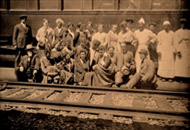
Share Your Comments & Feedback: